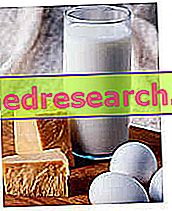Lactose intolerance
In case of severe intolerance towards this typical milk sugar, the exclusive consumption of lactose-free foods appears to be a forced choice.

Lactose is the main sugar present in milk; consequently, we find it in variable concentrations in all the foods derived from it or that contain it as an ingredient. The highest concentrations of lactose are found in milk, yogurt and fermented milks, ice creams, soft cheeses and butter.
Lactose content of various foods | |
Food | Lactose 100 g of food |
POWDER MILK POWDER (ENTIRE) | 35.1 |
POWDER MILK POWDER (MAGRO) | 50.5 |
| breast milk | 6.5-7.0 |
| donkey milk | 6.2 |
cheese | 6.0 |
| kefir | 5.0 * * |
BUFFALO MILK | 4.9 |
WHOLE VACCINE MILK | 4.8 |
Partially SKIMMED VACCINE MILK | 4.9 |
LEAN MILK VACCINE | 4.9 |
SHEEP'S MILK | 4.5 |
GOAT MILK | 4.2 |
FRESH VACCINE RICOTTA | 4.0 |
| cream | 3.0 -4 |
ROMAN RICOTTA OF SHEEP | 3.2 |
YOGURT FROM WHOLE MILK | 3.2 * * |
YOGURT DA LATTE MAGRO | 3.3 * * |
CREMA BEL PAESE | 3.2 |
MAGIC MILK FLAKES (cottage) | 2.6 to 3 |
MILK BREAD | 1.8 |
FRESH OR SEASONED EDAM | 1.0 |
| Mozzarella cheese | 0.1 to 1.1 |
| Emmentaler and hard cheeses | 0.1 |
| Parmigiano reggiano, grana padano and extra hard cheese | 0.0 |
* * Lactose contained in sour milk products is generally well tolerated
Normally, the lactose intolerant subject supports the consumption of hard cheeses, because they are particularly poor in this sugar compared to the fresh ones and dairy products. Even yogurt is tolerated by some individuals, given that the lactose it contains is pre-digested by bacteria; moreover, the same lactobacilli - in particular some probiotic strains contained in various products based on fermented milk ( Lactobacillus Acidophilus, Lactobacillus Casei, sp. rhamnosum, Lactobacillus johnsonii ) - have proved useful in improving lactose intolerance.
Lactose tolerance is variable and depends on each individual.
The severity of lactose intolerance is proportional to the lactase deficiency. It is therefore a relative concept, since the amount of lactose tolerated by the population is different; to clarify the concept with a practical example, if a person tolerates a cup of milk a day without any problem, he can still complain about the annoying symptoms of lactose intolerance when he consumes a liter in one go. Similarly, some lactose intolerant people tolerate yogurt well, some tolerate hard cheeses, while others are forced to eliminate even the smallest sources of lactose. To this last category belong the subjects suffering from intolerance to primary lactose, due to a congenital defect of lactase and therefore present since birth.
Individuals strongly intolerant to lactose must pay particular attention also to food sources so to speak "hidden". This sugar is in fact added as an excipient to various drugs and supplements, and is found - even in small quantities - in various food products. Among the latter we recall:
- bread and other baked goods
- processed cereals, like corn flakes for breakfast
- Pre-cooked potatoes, soups, drinks for breakfast
- Margarine
- Meat and cold cuts
- Salad dressings
- Candies, snacks and other snacks, ice cream, chocolate, prepared for hot chocolate
- Preparations for pancakes, biscuits and cakes
- Minced meat
- Soy milk does not contain lactose; however, due to the presence of other sugars typical of legumes (for example stachiosio) it can sporadically reproduce the symptoms of a lactose intolerance.
To defend against "hidden" sources of lactose, it is important to carefully read the composition of the food printed on the product labels. In the list of ingredients, in particular, it is necessary to ascertain the absence of milk and lactose, whey, rennet and milk by-products (lactic acid is not obtained from milk and is therefore suitable for consumption). Therefore, if one of these ingredients appears on the label, it means that the product contains lactose and therefore could be contraindicated. The conditional is obviously a must, precisely because lactose tolerance is variable and depends on each individual. What seems certain is that milk derivatives, but also various food products containing lactose, are important sources of nutrients. For this reason, an important piece of advice is to identify - through tests and errors - the tolerable amount of lactose, avoiding to assume only lactose-free foods.
If the intolerant individual wants to occasionally consume lactose-rich foods, he can take lactase-based enzymatic preparations at the same time as a palliative.
As far as calcium is concerned, in order to prevent any deficiencies, it is possible to take milk delactosate (only if well tolerated) and increase the consumption of bio-available vegetables rich in calcium (for example legumes, turnip greens, cabbage and broccoli). Fish and nuts are also excellent sources of calcium.



